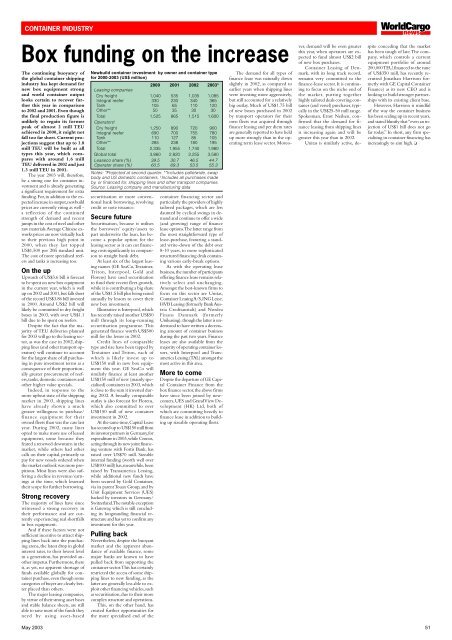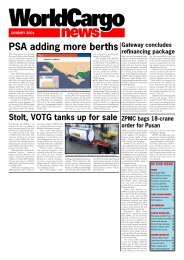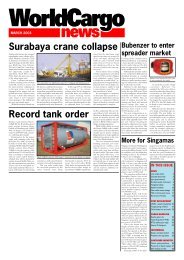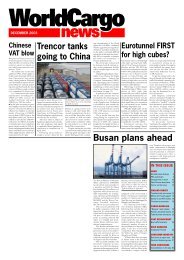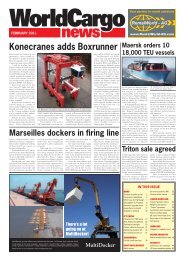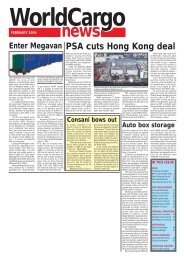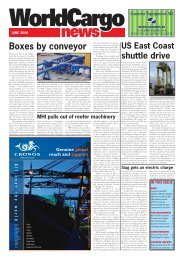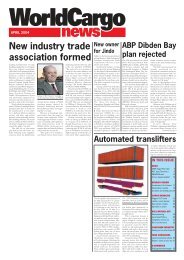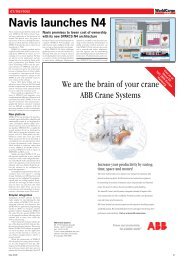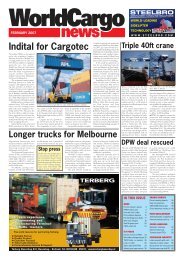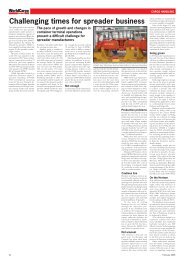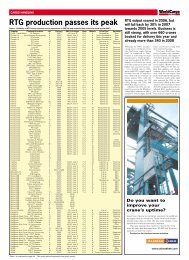Front Cover May - WorldCargo News Online
Front Cover May - WorldCargo News Online
Front Cover May - WorldCargo News Online
Create successful ePaper yourself
Turn your PDF publications into a flip-book with our unique Google optimized e-Paper software.
CONTAINER INDUSTRY<br />
Box funding on the increase<br />
The continuing buoyancy of<br />
the global container shipping<br />
industry has kept demand for<br />
new box equipment strong<br />
and world container output<br />
looks certain to recover further<br />
this year in comparison<br />
to 2002 and 2001. Even though<br />
the final production figure is<br />
unlikely to regain its former<br />
peak of almost 2 mill TEU<br />
achieved in 2000, it might not<br />
fall too far short. Current projections<br />
suggest that up to 1.8<br />
mill TEU will be built as all<br />
types this year, which compares<br />
with around 1.6 mill<br />
TEU delivered in 2002 and just<br />
1.3 mill TEU in 2001.<br />
The year 2003 will, therefore,<br />
be a strong one for container investment<br />
and is already generating<br />
a significant requirement for extra<br />
funding. For, in addition to the expected<br />
increase in output, newbuild<br />
prices are currently rising as well -<br />
a reflection of the continued<br />
strength of demand and recent<br />
jumps in the cost of steel and other<br />
raw materials. Average Chinese exworks<br />
prices are now virtually back<br />
to their previous high point in<br />
2000, when they last topped<br />
US$1,500 per 20ft standard unit.<br />
The cost of more specialised reefers<br />
and tanks is increasing too.<br />
On the up<br />
Upwards of US$3.6 bill is forecast<br />
to be spent on new box equipment<br />
in the current year, which is well<br />
up on 2002 and 2001, but falls short<br />
of the record US$3.86 bill invested<br />
in 2000. Around US$2 bill will<br />
likely be committed to dry freight<br />
boxes in 2003, with over US$1.1<br />
bill due to be spent on reefers.<br />
Despite the fact that the majority<br />
of TEU deliveries planned<br />
for 2003 will go to the leasing sector,<br />
as was the case in 2002, shipping<br />
lines (and other transport operators)<br />
will continue to account<br />
for the largest share of all purchasing<br />
in pure investment terms as a<br />
consequence of their proportionally<br />
greater procurement of reefers,<br />
tanks, domestic containers and<br />
other higher value specials.<br />
Indeed, in response to the<br />
more upbeat state of the shipping<br />
market in 2003, shipping lines<br />
have already shown a much<br />
greater willingness to purchase/<br />
finance equipment for their<br />
owned fleets than was the case last<br />
year. During 2002, many lines<br />
opted to make more use of leased<br />
equipment, some because they<br />
feared a renewed downturn in the<br />
market, while others had other<br />
calls on their capital, primarily to<br />
pay for new vessels ordered when<br />
the market outlook was more propitious.<br />
Most lines were also suffering<br />
a decline in revenue/earnings<br />
at the time, which lessened<br />
their scope for further borrowing.<br />
Strong recovery<br />
The majority of lines have since<br />
witnessed a strong recovery in<br />
their performance and are currently<br />
experiencing real shortfalls<br />
in box equipment.<br />
And if these factors were not<br />
sufficient incentive to attract shipping<br />
lines back into the purchasing<br />
arena, the latest drop in global<br />
interest rates, to their lowest level<br />
in a generation, has provided another<br />
impetus. Furthermore, there<br />
is, as yet, no apparent shortage of<br />
funds available globally for container<br />
purchase, even though some<br />
categories of buyer are clearly better<br />
placed than others.<br />
The major leasing companies,<br />
by virtue of their strong asset bases<br />
and stable balance sheets, are still<br />
able to raise most of the funds they<br />
need by using asset-based<br />
Newbuild container investment by owner and container type<br />
for 2000-2003 (US$ million)<br />
2000 2001 2002 2003*<br />
Leasing companies<br />
Dry freight 1,040 535 1,035 1,085<br />
Integral reefer 330 230 340 365<br />
Tank 105 65 110 120<br />
Other** 50 35 30 30<br />
Total 1,525 865 1,515 1,600<br />
Operators †<br />
Dry freight 1,250 890 720 900<br />
Integral reefer 690 700 755 780<br />
Tank 110 127 85 105<br />
Other** 285 238 180 195<br />
Total 2,335 1,955 1,740 1,980<br />
Global total 3,860 2,820 3,255 3,580<br />
Leaseco share (%) 39.5 30.7 46.5 44.7<br />
Operator share (%) 60.5 69.3 53.5 55.3<br />
Notes: *Projected at second quarter. **Includes palletwide, swap<br />
body and US domestic containers. † Includes all purchases made<br />
by, or financed for, shipping lines and other transport companies.<br />
Source: Leasing company and manufacturing data<br />
securitisation or more conventional<br />
bank borrowing, revolving<br />
credit or note issuance.<br />
Secure future<br />
Securitisation, because it utilises<br />
the borrowers’ equity/assets to<br />
part underwrite the loan, has become<br />
a popular option for the<br />
leasing sector as it can cut financing<br />
costs significantly in comparison<br />
to straight bank debt.<br />
At least six of the largest leasing<br />
names (GE SeaCo, Textainer,<br />
Tr iton, Interpool, Gold and<br />
Florens) have used securitisation<br />
to fund their recent fleet growth,<br />
while it is contributing a big share<br />
of the US$1.5 bill plus being raised<br />
annually by lessors to cover their<br />
new box investment.<br />
Illustrative is Interpool, which<br />
has recently raised another US$50<br />
mill through its long-running<br />
securitisation programme. This<br />
generated finance worth US$500<br />
mill for the lessor in 2002.<br />
Credit lines of comparable<br />
type and size have been tapped by<br />
Textainer and Triton, each of<br />
which is likely invest up to<br />
US$150 mill in new box equipment<br />
this year. GE SeaCo will<br />
similarly finance at least another<br />
US$150 mill of new (mainly specialised)<br />
containers in 2003, which<br />
is close to the sum it invested during<br />
2002. A broadly comparable<br />
outlay is also forecast for Florens,<br />
which also committed to over<br />
US$150 mill of new container<br />
investment in 2002.<br />
At the same time, Capital Lease<br />
has secured up to US$150 mill from<br />
its investor partners in Germany, for<br />
expenditure in 2003, while Cronos,<br />
acting through its new joint financing<br />
venture with Fortis Bank, has<br />
raised over US$70 mill. Sizeable<br />
internal funding (worth well over<br />
US$100 mill) has, meanwhile, been<br />
raised by Transamerica Leasing,<br />
while additional new funds have<br />
been secured by Gold Container,<br />
via its parent Touax Group, and by<br />
Unit Equipment Services (UES)<br />
backed by investors in Germany/<br />
Switzerland. The notable exception<br />
is Gateway, which is still concluding<br />
its longstanding financial restructure<br />
and has yet to confirm any<br />
investment for this year.<br />
Pulling back<br />
Nevertheless, despite the buoyant<br />
market and the apparent abundance<br />
of available finance, some<br />
major banks are known to have<br />
pulled back from supporting the<br />
container sector. This has certainly<br />
restricted the access of some shipping<br />
lines to new funding, as the<br />
latter are generally less able to exploit<br />
other financing vehicles, such<br />
as securitisation, due to their more<br />
complex structure and operations.<br />
This, on the other hand, has<br />
created further opportunities for<br />
the more specialised end of the<br />
The demand for all types of<br />
finance lease was naturally down<br />
slightly in 2002, as compared to<br />
earlier years when shipping lines<br />
were investing more aggressively,<br />
but still accounted for a relatively<br />
big outlay. Much of US$1.75 bill<br />
of new boxes purchased in 2002<br />
by transport operators for their<br />
own fleets was acquired through<br />
finance leasing and per diem rates<br />
are generally reported to have held<br />
up more strongly than in the operating<br />
term lease sector. Moreocontainer<br />
financing sector and<br />
particularly the providers of highly<br />
tailored packages, which are less<br />
daunted by cyclical swings in demand<br />
and continue to offer a wide<br />
(and growing) range of finance<br />
lease options. The latter range from<br />
the most straightforward type of<br />
lease-purchase, featuring a standard<br />
write-down of the debt over<br />
8-10 years, to more sophisticated<br />
structured financing deals containing<br />
various early-break options.<br />
As with the operating lease<br />
business, the number of participants<br />
offering finance lease remains relatively<br />
select and unchanging.<br />
Amongst the best-known firms to<br />
focus on this sector are Unitas,<br />
Container Leasing A/S, ING Lease,<br />
HVB Leasing (formerly Bank Austria<br />
Creditanstalt) and Nordea<br />
Finans Danmark (formerly<br />
Unileasing), though the latter is understood<br />
to have written a decreasing<br />
amount of container business<br />
during the past two years. Finance<br />
leases are also available from the<br />
majority of operating container lessors,<br />
with Interpool and Transamerica<br />
Leasing (TAL) amongst the<br />
most active in this area.<br />
More to come<br />
Despite the departure of GE Capital<br />
Container Finance from the<br />
box finance sector, the above firms<br />
have since been joined by newcomers,<br />
UES and Grand View Development<br />
(HK) Ltd, both of<br />
which are committing heavily to<br />
finance lease in addition to building<br />
up sizeable operating fleets.<br />
<strong>WorldCargo</strong><br />
news<br />
ver, demand will be even greater<br />
this year, when operators are expected<br />
to fund almost US$2 bill<br />
of new box purchases.<br />
Container Leasing of Denmark,<br />
with its long track record,<br />
remains very committed to the<br />
finance-lease sector. It is continuing<br />
to focus on the niche end of<br />
the market, putting together<br />
highly tailored deals covering container<br />
(and vessel) purchases, typically<br />
in the US$25-50 mill range.<br />
Spokesman, Ernst Neilsen, confirmed<br />
that the demand for finance<br />
leasing from shipping lines<br />
is increasing again and will be<br />
greater this year than in 2002.<br />
Unitas is similarly active, despite<br />
conceding that the market<br />
has been tough of late. The company,<br />
which controls a current<br />
equipment portfolio of around<br />
200,000 TEU, financed to the tune<br />
of US$350 mill, has recently recruited<br />
Jonathan Harrison formerly<br />
with GE Capital Container<br />
Finance) as its new CEO and is<br />
looking to build stronger partnerships<br />
with its existing client base.<br />
However, Harrison is mindful<br />
of the way the container business<br />
has been scaling up in recent years,<br />
and stated bluntly that “even an injection<br />
of US$1 bill does not go<br />
far today.” In short, any firm specialising<br />
in container financing has<br />
increasingly to aim high. ❏<br />
<strong>May</strong> 2003 51


